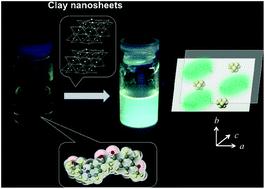当前位置:
X-MOL 学术
›
Photochem. Photobiol. Sci.
›
论文详情
Our official English website, www.x-mol.net, welcomes your feedback! (Note: you will need to create a separate account there.)
Electronic interactions between a quaternary pyridyl-β-diketonate and anionic clay nanosheets facilitate intense photoluminescence.
Photochemical & Photobiological Sciences ( IF 3.1 ) Pub Date : 2020-07-21 , DOI: 10.1039/d0pp00166j Tomohiko Okada 1 , Yoko Miyamoto 2 , Haruka Kurihara 2 , Yoshifumi Mochiduki 3 , Shiho Katsumi 3 , Fuyuki Ito 3
Photochemical & Photobiological Sciences ( IF 3.1 ) Pub Date : 2020-07-21 , DOI: 10.1039/d0pp00166j Tomohiko Okada 1 , Yoko Miyamoto 2 , Haruka Kurihara 2 , Yoshifumi Mochiduki 3 , Shiho Katsumi 3 , Fuyuki Ito 3
Affiliation

|
Electrostatic interactions between a quaternary pyridyl-β-diketonate and anionic charged nanosheets were observed to produce a highly emissive dispersion in a rich water solution. A greater fluorescence quantum yield of approximately 50% was obtained when a luminogenic β-diketonate, 1-(4-methoxyphenyl)-3-(3-hydroxyethyl-pyridinium bromide)-1,3-propandione (prepared by the Claisen condensation reaction and subsequent quaternization), was molecularly dispersed and enclosed by a couple of atomically flat ultrathin (approximately 1.0 nm) silicate sheets of anionic layered clay. By accommodating β-diketonate into a narrow interlamellar space (approximately 0.4 nm distance), the molecular motion was suppressed, as confirmed by a smaller non-radiative relaxation rate constant, which was obtained by time-resolved luminescence and quantum yield measurements. Because the dense packing of β-diketonate quenched the excited state, the isolation of luminogens by the co-adsorption of photochemical inert cations (tetramethylammonium and benzylammonium) was prevented by concentration quenching. A lower quantum yield was obtained by expanding the interlayer distance above 1.0 nm by co-adsorbing a photo-inactive water-soluble polymer, poly(vinylpyrrolidone). Therefore, the fixation and spatial separation of β-diketonate in the narrow interlayer space was determined to be essential for obtaining strong emission.
中文翻译:

季吡啶基-β-二酮酸酯和阴离子粘土纳米片之间的电子相互作用促进了强烈的光致发光。
季吡啶基-β-二酮酸酯与阴离子带电纳米片之间的静电相互作用被观察到,可以在富水溶液中产生高发射率的分散体。当发光的β-二酮酸酯,1-(4-甲氧基苯基)-3-(3-羟乙基溴化吡啶鎓)-1,3-丙二酮(通过克莱森缩合反应制备和随后进行季铵化),将其分子分散,并用几层原子层状粘土的原子平面超薄(约1.0 nm)硅酸盐片包围。通过将β-二酮酸酯容纳在一个狭窄的层间空间(约0.4 nm的距离)中,抑制了分子运动,这是由较小的非辐射弛豫速率常数所证实的,通过时间分辨的发光和量子产率测量获得。因为β-二酮酸酯的致密堆积可以猝灭激发态,所以通过浓度猝灭可以防止通过光化学惰性阳离子(四甲基铵和苄基铵)的共吸附而分离出发光剂。通过共吸附光不活泼的水溶性聚合物聚(乙烯基吡咯烷酮),将层间距离扩大到1.0 nm以上,可以得到较低的量子产率。因此,确定了β-二酮酸酯在狭窄的层间空间中的固定和空间分离对于获得强发射至关重要。浓度猝灭可防止通过光化学惰性阳离子(四甲基铵和苄基铵)的共吸附而分离出发光剂。通过共吸附光不活泼的水溶性聚合物聚(乙烯基吡咯烷酮),将层间距离扩大到1.0 nm以上,可以得到较低的量子产率。因此,确定了β-二酮酸酯在狭窄的层间空间中的固定和空间分离对于获得强发射至关重要。浓度猝灭可防止通过光化学惰性阳离子(四甲基铵和苄基铵)的共吸附而分离出发光剂。通过共吸附光不活泼的水溶性聚合物聚(乙烯基吡咯烷酮),将层间距离扩大到1.0 nm以上,可以得到较低的量子产率。因此,确定了β-二酮酸酯在狭窄的层间空间中的固定和空间分离对于获得强发射至关重要。
更新日期:2020-07-21
中文翻译:

季吡啶基-β-二酮酸酯和阴离子粘土纳米片之间的电子相互作用促进了强烈的光致发光。
季吡啶基-β-二酮酸酯与阴离子带电纳米片之间的静电相互作用被观察到,可以在富水溶液中产生高发射率的分散体。当发光的β-二酮酸酯,1-(4-甲氧基苯基)-3-(3-羟乙基溴化吡啶鎓)-1,3-丙二酮(通过克莱森缩合反应制备和随后进行季铵化),将其分子分散,并用几层原子层状粘土的原子平面超薄(约1.0 nm)硅酸盐片包围。通过将β-二酮酸酯容纳在一个狭窄的层间空间(约0.4 nm的距离)中,抑制了分子运动,这是由较小的非辐射弛豫速率常数所证实的,通过时间分辨的发光和量子产率测量获得。因为β-二酮酸酯的致密堆积可以猝灭激发态,所以通过浓度猝灭可以防止通过光化学惰性阳离子(四甲基铵和苄基铵)的共吸附而分离出发光剂。通过共吸附光不活泼的水溶性聚合物聚(乙烯基吡咯烷酮),将层间距离扩大到1.0 nm以上,可以得到较低的量子产率。因此,确定了β-二酮酸酯在狭窄的层间空间中的固定和空间分离对于获得强发射至关重要。浓度猝灭可防止通过光化学惰性阳离子(四甲基铵和苄基铵)的共吸附而分离出发光剂。通过共吸附光不活泼的水溶性聚合物聚(乙烯基吡咯烷酮),将层间距离扩大到1.0 nm以上,可以得到较低的量子产率。因此,确定了β-二酮酸酯在狭窄的层间空间中的固定和空间分离对于获得强发射至关重要。浓度猝灭可防止通过光化学惰性阳离子(四甲基铵和苄基铵)的共吸附而分离出发光剂。通过共吸附光不活泼的水溶性聚合物聚(乙烯基吡咯烷酮),将层间距离扩大到1.0 nm以上,可以得到较低的量子产率。因此,确定了β-二酮酸酯在狭窄的层间空间中的固定和空间分离对于获得强发射至关重要。



























 京公网安备 11010802027423号
京公网安备 11010802027423号